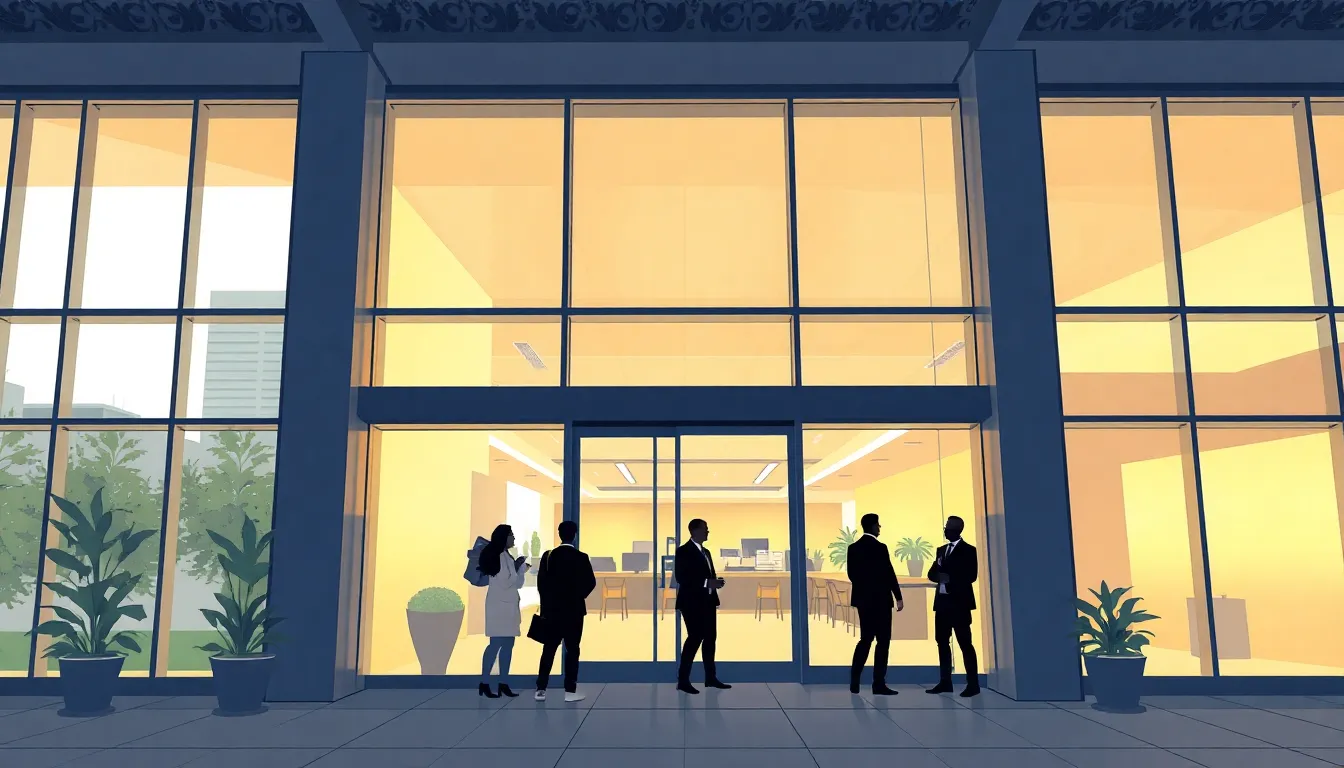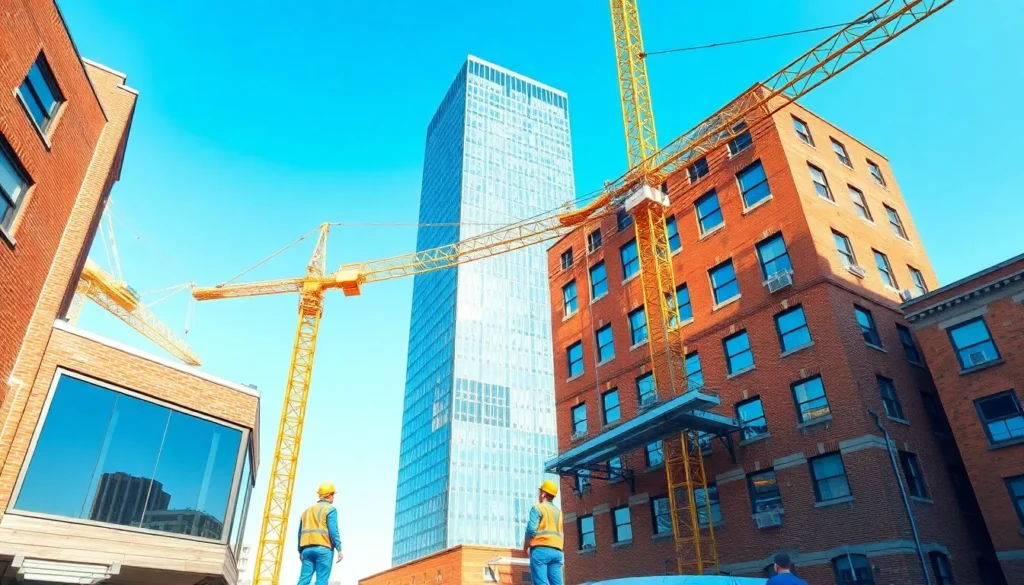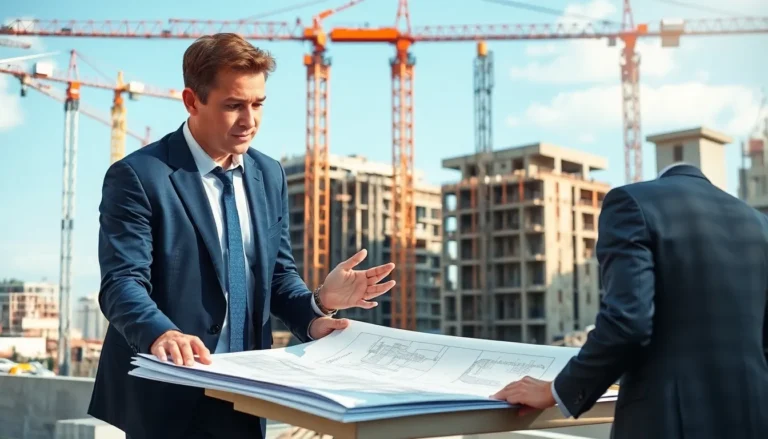Table of Contents
ToggleWhen it comes to commercial building construction, one size definitely doesn’t fit all. From sleek glass skyscrapers that scrape the sky to cozy brick-and-mortar shops that feel like home, the choices are as varied as a buffet at a five-star restaurant. Each construction type serves a unique purpose and caters to different needs, making it essential for business owners to understand their options before breaking ground.
Overview of Commercial Building Construction Types
Commercial building construction encompasses various types, each tailored to specific functions and needs. Office buildings often prioritize functionality and collaboration, featuring open spaces and meeting rooms. Retail structures focus on visibility and accessibility, designed to attract customers.
Industrial buildings, such as warehouses and manufacturing facilities, emphasize durability and space efficiency. These structures often include large openings for machinery and storage. Multifamily housing units serve a different purpose, providing residential spaces within a commercial framework.
Healthcare facilities, ranging from hospitals to clinics, require thoughtful design to enhance patient experience and operational efficiency. They often comprise specialized areas for treatment, waiting, and administration.
Educational institutions emphasize flexibility and safety, accommodating classrooms and recreational areas. These buildings often include outdoor spaces for student interaction.
Hospitality structures, such as hotels and resorts, focus on creating inviting environments, combining comfort with services like dining and recreation. Convention centers cater to large gatherings, providing extensive space and advanced technology for events.
Each construction type supports unique business objectives, emphasizing the importance of understanding these distinctions. Proper project planning ensures that every commercial building aligns with operational requirements and regulatory standards. Consideration of local zoning laws and environmental impact further affects construction choices.
Knowledge of these diverse building types forms a foundation for successful construction projects, helping business owners achieve their strategic goals.
Types of Commercial Buildings

A variety of commercial building types exists, each tailored to specific business needs. Understanding these categories helps inform construction decisions.
Office Buildings
Office buildings emphasize functionality and collaboration. Structures can range from single-story spaces to towering high-rises, featuring open floor plans that encourage teamwork. Specific designs often incorporate amenities like meeting rooms, lounges, and tech facilities to enhance productivity. Various styles exist, including traditional, modern, and mixed-use options, allowing for flexibility in meeting specific corporate requirements.
Retail Establishments
Retail establishments prioritize visibility and accessibility to attract customers. These buildings include shopping centers, boutiques, and large department stores designed with attention to foot traffic flow. Key features focus on storefront designs and displays that engage consumers. They often incorporate parking spaces and outdoor areas to enhance the shopping experience. Different layouts cater to specific retail needs, whether it’s a large chain or a small specialty shop.
Industrial Facilities
Industrial facilities focus on durability and space efficiency. These buildings include warehouses, manufacturing plants, and distribution centers with designs that accommodate heavy machinery and large inventories. Functionality drives layout considerations, often utilizing open spaces for maximal operational efficiency. Specific features include loading docks, high ceilings, and robust infrastructure to support rigorous activities. Different configurations arise depending on industry requirements and storage needs.
Hospitality Structures
Hospitality structures are designed to enhance guest experiences. These include hotels, motels, and resorts, where comfort and service rank as top priorities. Layouts typically feature guest rooms, dining areas, and recreational facilities to create an inviting atmosphere. Architectural styles vary, reflecting target markets and locations, from luxury resorts to budget-friendly accommodations. Specific design elements aim to maximize guest satisfaction and operational efficiency.
Construction Methods
Commercial building construction encompasses various methods, each tailored to specific project requirements. Understanding these methods aids in making informed decisions during the construction process.
Traditional Construction
Traditional construction involves using conventional materials such as wood, concrete, and steel. This method often includes on-site groundbreaking and structure assembly. Contractors benefit from the familiarity of established practices, enabling them to manage complex designs effectively. Structural integrity often improves with this method, yielding sturdier, long-lasting buildings. Project timelines might extend due to labor-intensive processes, yet personalized design opportunities arise.
Modular Construction
Modular construction employs pre-fabricated sections assembled on-site. This innovative approach dramatically reduces construction time, as modules are built simultaneously in a controlled environment. Efficiency is a key advantage, allowing for quicker occupancy and reduced labor costs. Quality control during the module fabrication phase enhances overall durability. Flexibility in design also exists, accommodating various architectural styles while adhering to safety standards.
Green Building Practices
Green building practices focus on sustainability and environmental responsibility. These methods prioritize energy efficiency, utilizing renewable resources and eco-friendly materials. Incorporating features such as solar panels and green roofs improves energy management effectively. Long-term operating costs decrease through lower energy consumption and maintenance. Regulatory compliance and certifications, like LEED, support the adoption of these practices, appealing to environmentally conscious investors.
Factors Influencing Construction Type Selection
Selecting a construction type involves multiple factors that significantly affect project outcomes. Understanding these variables aids business owners in making informed decisions tailored to their specific needs.
Budget Considerations
Budget constraints play a critical role in determining the construction type. A limited budget may favor traditional construction methods, which utilize standard materials like wood and concrete. These options often provide structural integrity at a lower cost. In contrast, advanced methods such as modular construction may require higher upfront investments but result in reduced completion time and lower overall costs. Efficient project management alongside accurate budgeting ensures that financial resources align with desired building specifications, allowing businesses to strike a balance between quality and affordability.
Regulatory Requirements
Regulatory requirements must guide construction type selection. Local building codes often dictate specific structural features essential for compliance. Zoning laws may affect the height, design, and use of commercial properties, influencing the choice significantly. Understanding these regulations ensures that the selected construction type meets legal standards, avoiding costly delays and potential legal issues. Consultation with local authorities and building professionals can help navigate these complexities effectively, ensuring that the final design complies with regulations.
Environmental Impact
Environmental impact drives choices in construction types. Sustainable building practices are crucial for reducing carbon footprints and supporting long-term ecological balance. Businesses increasingly prefer green construction methods, like using eco-friendly materials and energy-efficient designs. By opting for sustainable practices, companies can attract eco-conscious customers while benefiting from potential tax incentives and lower operational costs. Assessing the environmental impact alongside other factors leads to informed decisions that support both business objectives and ecological responsibility.
Understanding the various types of commercial building construction is essential for business owners. Each construction type offers unique advantages tailored to specific operational needs. By considering factors like budget, regulatory requirements, and environmental impact, they can make informed decisions that align with their goals.
Choosing the right construction method not only enhances functionality but also contributes to long-term success. Whether opting for traditional materials or embracing modern modular techniques, the right approach can significantly influence a project’s outcome. Ultimately, a well-planned construction strategy lays the foundation for a thriving business environment.







